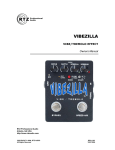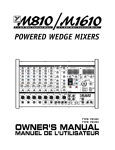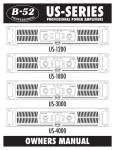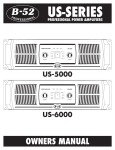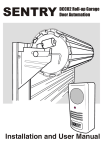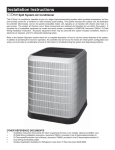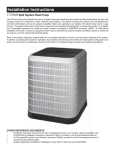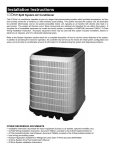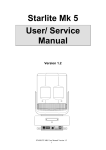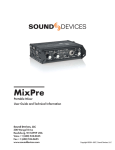Download RTZ 9762 Specifications
Transcript
PRELIMINARY Model 9762 ALL INFORMATION SUBJECT TO CHANGE DUAL-COMBO MICROPHONE PREAMPLIFIER Owners Manual RTZ Professional Audio 4260 Pine Vista Blvd Alpharetta, GA 30022 USA http://www.rtzaudio.com COPYRIGHT © 2003-2004, RTZ AUDIO REV-C 12/06/2004 TABLE OF CONTENTS 1 WELCOME!............................................................................................................................. 1 2 OVERVIEW ............................................................................................................................. 1 3 AC VOLTAGE SELECT AND SAFETY FUSES .................................................................... 2 3.1 INTERNAL PREAMPLIFIER SAFETY FUSES ............................................................................ 2 3.2 LINE VOLTAGE SELECT AND AC FUSE ................................................................................ 2 4 INSTALLATION AND CONNECTIONS.................................................................................. 3 4.1 AC POWER CONNECTOR ................................................................................................... 3 4.2 BALANCED CONNECTORS................................................................................................... 3 4.3 UNBALANCED CONNECTORS .............................................................................................. 3 5 DESIGN FEATURES .............................................................................................................. 4 5.1 5.2 5.3 5.4 INPUT STAGES ................................................................................................................... 4 PHANTOM POWER ............................................................................................................. 4 GAIN BLOCKS AND METERING ............................................................................................ 5 LINE AMPLIFIER STAGE ...................................................................................................... 5 6 THE CONTROLS .................................................................................................................... 6 7 OPERATION ........................................................................................................................... 8 7.1 7.2 7.3 7.4 7.5 8 GAIN AND LEVEL ADJUSTMENTS ......................................................................................... 8 USING THE DI INPUT .......................................................................................................... 8 POLARITY AND IMPEDANCE SELECTION ............................................................................... 9 USING 48V PHANTOM POWER ........................................................................................... 9 LINE OUTPUT TRANSFORMER TERMINATION........................................................................ 9 SPECIFICATIONS ................................................................................................................ 10 Model 9762 – Dual Combo Owners Manual 1 Welcome! Thank you for purchasing your new Model 9762 Dual-Combo Microphone Preamplifier! Before operating or installing the unit, please read this manual thoroughly and retain it for future reference. Additional copies of this manual are available upon request or from our website at http://www.rtzaudio.com. All units are carefully packed to endure the rigors of shipping and handling. However, please inspect all contents and packaging immediately upon receipt. Please report any problems to us immediately. In the event of damage, retain all shipping and packaging materials for shipper damage claims inspection. The 9762 is designed to deliver a lifetime of musical pleasure and trouble free operation. If you experience any problems or difficulties, please contact us directly. Do not attempt to modify, alter or repair the unit yourself. Each unit has been carefully tested and calibrated for proper operation. Any unauthorized modifications may destroy the unit or severely degrade performance and void the warranty. 2 Overview The 9762 preamplifier is designed to emulate the vintage 1970s large format consoles (i.e. Neve 1073 Series) yet provide a more open and detailed sound by using modern components and transformers. We use a super high quality input transformer (manufactured by Lars Lundahl of Sweden) with excellent sonic performance. This transformer is considered by many to be one of the world’s finest input transformers. The preamp gain blocks and gain structure have been optimized to match the input transformer impedance characteristics as closely as possible. This combination of classic circuitry and a modern input transformer allows the 9762 to deliver a classic super fat sound with the benefit of increased high-end openness and clarity. The standard unit contains two channels of high gain amplification capable of providing up to 75 dB of gain. All XLR input and output connectors are transformer balanced and isolated. Unbalanced line output connectors and direct input (DI) instrument connectors are also provided. Standard features include +48V Phantom power, polarity (phase) reverse, DI input source select, microphone impedance select and output termination switching. The internal power transformer may be configured for either 115V or 230V (50/60 Hz) operation via the rear panel power entry module. Each preamplifier circuit board contains onboard regulation, filtering and a thermal safety fuse that operates completely independently from the other channel. The internal safety fuses protects each channel’s amplifier board against major damage in the unlikely event of component failure. RTZ Professional Audio Model 9762 – Dual Combo Owners Manual 3 AC Voltage Select and Safety Fuses The 9762 may be configured for either 115V or 230V operation at 50 / 60 Hz via the line voltage select card inside the power entry module on the rear panel. Always disconnect power and remove all connectors from the unit before servicing or changing the line voltage configuration. 3.1 Internal Thermal Safety Fuses The +24V status LED’s on each channel show power and regulator status for that channel. The internal thermal fuse may be in the tripped state if a channel’s +24V LED fails to illuminate at power up. The thermal fuses are auto-reset devices and do not require replacement. If a channel fails to indicate power status, turn the unit off and allow 10 minutes for it to cool down before reapplying power. If power status continues to fail the unit should be returned to the factory for inspection and/or repair. 3.2 Line Voltage Select and AC Fuse To change the AC line voltage selection, disconnect the power plug and remove the IEC power cord from the power entry module on the rear of the unit, slide the fuse cover door to the left and rotate the fuse-pull lever to the left to eject the fuse. Remove the voltage select card and choose the correct operating voltage by orienting the voltage selection card as marked. Push the card firmly into the module slot, rotate the fuse-pull lever back into normal position and insert the correct fuse type as specified in Table 1 below. Table 1 – AC Line Fuse Requirements Voltage 115 VAC 230 VAC RTZ Professional Audio Rating 0.375 A @ 250V 0.175 A @ 250V Type 3AG Slo-Blo Fuse 3AG Slo-Blo Fuse Model 9762 – Dual Combo Owners Manual 4 Installation and Connections The 9762 is designed for standard 1U 19” rack mounting. Ideally, the unit should be mounted where cool air flows across the unit. Do not obstruct the flow of air around and across the preamplifier enclosure. In tight equipment enclosures, consider placing a ventilated rack panel to allow increased airflow. Do not place the unit near strong magnetic fields and noise sources such as power amplifiers, console power supplies, transformers, motors, florescent lighting, computers, etc. 4.1 AC Power Connector The 9762 accepts a standard IEC AC line cord and may be configured for either 115V or 230V AC line voltage (50 or 60 Hz) as required from the rear panel power entry module. All units shipped in the USA are configured for standard 115 VAC operation. Refer to the Line Voltage Configuration section of this manual for line voltage configuration information. NOTE ALWAYS ENSURE THAT THE PREAMPLIFIER IS PROPERLY GROUNDED AT THE AC LINE CORD. NEVER USE A CORD WITH A MISSING GROUND PIN OR GROUND LIFTING ADAPTER. THE AMPLIFIERS REQUIRE A COMMON EARTH GROUND FOR PROPER OPERATION. A FAULTY OR MISSING GROUND PRESENTS A SAFTEY HAZARD AND MAY ALSO RESULT IN IMPROPER OPERATION. 4.2 Balanced Connectors The rear panel XLR input and output connectors are designed for balanced operation. The XLR connectors follow modern standards for XLR wiring conventions as follows: Table 2 – Balanced Connectors XLR Pin 1 2 3 Connection Ground Hot (+) Cold (-) The balanced line output may also be used to drive unbalanced loads by connecting pins 1 and 3 together (to Sleeve) and pin 2 to hot (to Tip). Do not float pin 3 as the output transformer secondary is floating and balanced. Unbalanced operation requires that pin 3 be connected to a ground. 4.3 Unbalanced Connectors The unbalanced ¼” line output and DI input connectors accept Tip and Sleeve (TS) or Tip, Ring and Sleeve (TRS) connectors. The Tip is always treated as hot and the Ring and Sleeve are always referenced to the internal preamp ground. This design allows the use of TS or TRS ¼” connectors to simplify interfacing the unit with other balanced or unbalanced gear. RTZ Professional Audio Model 9762 – Dual Combo Owners Manual 5 Design Features The 9762 has been designed and built with great attention to detail. In particular, the input transformer and gain stepping network have been painstakingly matched and optimized to present the proper load impedance to the microphone at all gain settings. This refinement combined with a super high quality input transformer gives the 9762 a more detailed sound when compared to vintage units. The enclosure and faceplate are made of heavy gauge steel for extra strength and maximum shielding. All audio transformers and the AC line power supply transformer are shielded internally with mu-metal housings for maximum isolation and hum reduction. The power supply uses a custom designed low noise audio grade toroidial type transformer. 5.1 Input Stages The input transformers are optimized for 200-Ohm impedance microphones or other devices having 200-Ohm source impedance. The LO-Z impedance select switch configures the transformer input for either 50-Ohm (LO-Z) or 200-Ohm source impedance. Keep in mind that the impedance select switching is accomplished by configuring the input transformer primary wiring as either a series or parallel circuit, which affects the transformer’s turns ratio. By nature, the impedance switching affects the signal level by roughly 6 dB when switching impedances. Miniature sealed gold contact relays are used for all audio switching functions and increased reliability. The input stages include additional muting logic for silent switching. Note that the mute logic circuitry uses a special dual FET shunt type design for transparent mute operation without degrading or coloring the audio signal path. The audio signal does not actually pass through the FET devices, but instead, the FETs act as shunt switches to mute the output signal during switching operations. A high impedance FET buffer stage is used in the instrument direct input (DI) stage. The FET input buffer stage serves as a high impedance conversion stage designed to prevent loading of the instrument pickups. The DI switch allows manual selection of the DI or microphone input source. Additionally the DI select switch may also serve as a channel mute switch when the DI or microphone input is not in use. 5.2 Phantom Power The phantom power switching circuitry uses a smooth power ramping design to reduce pops and clicks during switching. The phantom voltage ramps up gradually when enabled and gradually ramps down when disabled. A high voltage regulator on the power supply circuit board provides phantom power for both channels and is fully protected against continuous shorting via each channel’s current limiting resistors. RTZ Professional Audio Model 9762 – Dual Combo 5.3 Owners Manual Gain Blocks and Metering The 9762 provides up to 75 dB maximum gain using a dual gain block type design. Gain is selectable from –20 dB to -75 dB in 5 dB increments via the twelve position rotary switch. At higher gain settings (above -50 dB), a second gain block is inserted into the signal path for additional gain and increased headroom. The input signal stages are designed for maximum headroom throughout the audio path at any gain setting. The SP (signal present) and OL (overload) LED’s provide input stage signal monitoring. In normal use the OL should not light to prevent signal distortion. The signal quality degrades rather quickly once the OL threshold is reached. The SP and OL LED’s monitor channel activity and clipping for the signal source currently selected by the DI switch. The five LED VU meter monitors the master output level from the line amplifier stage. The first LED lights at –10 dBu with subsequent steps at –5 dBu, 0 dBu, +3 dBu and +6 dBu. The master LEVEL control is used to trim the output level using the VU meter as a level reference. 5.4 Line Amplifier Stage The line amplifier stage input level is controlled by the master LEVEL control. The LEVEL control acts as a channel fader to trim the line amplifier output as needed. In general, the LEVEL control should be set to the maximum position (fully CW) and the input GAIN control is then adjusted to obtain the desired output signal level. If the output signal is slightly “hot”, use the LEVEL control to trim the output level back to obtain the desired output signal level. In situations where distortion or warmth is desired, the input GAIN setting may be set “hot” and the output LEVEL control is used to trim the output back to a suitable level. Use care with this technique to avoid overdriving the input stage excessively as the signal becomes very ugly sounding at extremes. Also, keep in mind the line amplifier stage is capable of delivering very large output level swings (around 40V peak-to-peak!); excessive signal levels may potentially damage the input stages of gear being driven by the 9762. The rear panel unbalanced ¼” line outputs are driven directly from the line amplifier stage and bypass the output transformer completely. The balanced XLR output connectors are generally preferred as these may be used in balanced or unbalanced wiring configurations (refer to Section 4.2). However, the unbalanced connectors provide other options for interfacing with various types of equipment and gear. Recall that cable lengths should be kept to a minimum with unbalanced signals and proper grounding must be paid attention to. RTZ Professional Audio Model 9762 – Dual Combo Owners Manual 6 The Controls 1. +24V Status Indicator This LED indicates +24V power status for each channel. If both channel power LED’s fail to light when the unit is powered on, check to make sure the AC outlet and line cord are working properly, otherwise, check the AC line fuse on the rear panel of the unit. If a channel fails to indicate power status, it is possible the internal thermal fuse has tripped and the unit may require servicing. 2. Direct Input (DI) – Unbalanced The Direct Input is designed for use with instrument sources and is buffered by a Hi-Z FET stage to avoid instrument pickup loading. The input connector accepts standard ¼“ Phone Plugs in either TS (Mono – TIP, SLEEVE) or TRS (Stereo – TIP, RING, SLEEVE). Note that when TRS connectors are used, the RING and SLEEVE are both referenced to ground internally. The DI input may also be used as an unbalanced direct input, however, line level +4 dBu signal levels will most likely result in distortion. In this case, the signal level should be reduced from the source. 3. DI Source Enable The DI switch selects the preamp input signal from either the unbalanced DI input jack or the balanced Microphone Input connector on the rear panel. The DI input jack is selected in the depressed position; otherwise the balanced XLR microphone input connector is selected. Note that the DI switch may also serve as a “MUTE” switch when only one input source is being used. 4. Signal Present (SP) Indicator The SP LED indicates signal activity on a channel. The detector is sourced from the gain blocks prior to the line amplifier and output LEVEL control. The LED lights around 200mV peak-to-peak (approximately –20 dB referenced to 775 mV). RTZ Professional Audio Model 9762 – Dual Combo Owners Manual 5. Signal Overload (OL) Indicator This LED indicates signal overload/clipping conditions at the input gain block stages. In normal use the LED should not light or flicker. Reduce the input GAIN switch to lower the input gain and avoid clipping. 6. Output Level VU Meter The five LED’s provide output VU Meter level indication sourced from the line output amplifier at +6, +3, 0, -5 and –10 dB. The “0” LED indicates 0 dB output level referenced to +4 dBm. 7. +48V Phantom Power Enable This switch enables +48V phantom microphone power on the rear microphone input connector. The LED next to the switch lights when phantom power is active. The +48V switch controls circuitry that ramps the 48V power up or down gradually to reduce unwanted bangs or pops in the audio signal. 8. Microphone Low-Z Impedance Enable This switch configures the input transformer for Low-Z impedance mode. The input transformer and circuitry is optimized for 50-Ohm microphones or other devices having 50Ohm source impedance. In the non-depressed state the input transformer is configured for 200-Ohm source impedance. Note that the input signal level varies by approximately 6 dB when the switch is operated. When changing impedances, adjust the gain switch to compensate for the level change and to avoid masking the tonal differences between impedance settings. 9. Polarity Invert Enable This switch inverts the line output polarity (phase) in the depressed position. Note that this switch operates a relay wired to the line output transformer and has no effect on the unbalanced ¼ “ line output connector. Thus, the polarity of the unbalanced output is always fixed in the non-inverted state. An alternative is to wire the balanced XLR output connector for unbalanced operation as described in Section 4.3. 10. Gain Sensitivity Switch The rotary gain switch has twelve positions that select the input sensitivity in 5 dB increments from -20 dB to –75 dB for a maximum gain of 75 dB. The unit is set to maximum gain in the fully CW position. Always start at the lowest gain setting and increase the gain to obtain the desired output level. 11. Line Output Termination Enable This switch enables the line output transformer termination resistor in the depressed state. The transformer requires proper termination for optimal flat frequency response. This switch is useful for bridging and balanced operating modes. In most cases the termination select should be enabled for flattest response. Note that the response will exhibit a slight HF rise around 20 kHz with no termination enabled. This technique may also be used to obtain additional “air” in the signal path when desired. Experiment with the termination switch during recording and note the effect on the audio signal while changing states. 12. Output Level Control The output level control acts as a master fader to facilitate fine trimming of the output signal level from –90 to 0 dB as required. In normal operation this control should be set to maximum level (fully CW position) and then trimmed back as needed to obtain the desired output signal level. RTZ Professional Audio Model 9762 – Dual Combo Owners Manual 7 Operation The 9762 is designed for convenience and ease of use. In general you should experiment with a variety of microphones, placements and settings to achieve best results. The 9762 works well with all types of balanced microphones (dynamic and condenser) and is exceptionally suited for use with ribbon type microphones. The preamplifier may be located in the studio control room or in the recording room itself. Ideally there should be a minimum of additional cables, boxes or connectors between the unit and the microphones for best results. The use of high-quality microphones and cables with gold connectors are highly recommended. Always insure the unit is properly grounded to prevent undesirable operation. 7.1 Gain and Level Adjustments In normal use the output LEVEL control should be set to the maximum position (fully CW). The LEVEL control acts as a master fader control for overall output level adjustment. The line amplifier input stage is sourced from the LEVEL control and provides up to 10 dB gain. Thus, the output LEVEL control is used for any adjustment or trimming of the master output level. Typically the line output of the preamplifier directly feeds a track on a recorder or other piece of inline gear. Always start with the lowest setting on the GAIN switch (fully CCW in the –20 dB position) and increase the sensitivity to obtain the desired record level. If the output level is slightly higher than desired, trim the output level back using the LEVEL control. The SP signal present indicator lights to indicate signal activity. Under normal operation, the OL overload indicator should not light for the most accurate results. Any clipping of the input stages will result in distortion. If clipping occurs, reduce the input GAIN sensitivity switch to an acceptable level. The output VU meter allows monitoring the output signal level while adjusting the GAIN and LEVEL controls. 7.2 Using the DI Input Recall the DI source select switch selects the front panel instrument input jack in the depressed state. The DI input is primarily designed for use with electric guitar, bass or similar instruments. The DI input may also be used with other sources such as electronic keyboards if the source’s output signal level is kept to a reasonably low level. However, line level signals of +4 dBm or greater will most likely result in distortion. The DI switch also serves as a mute switch when only one input source is being used (either the DI input jack or the microphone input). For instance, if you are only using the microphone input and no cable is plugged into the DI instrument input, press the DI switch to mute the microphone input. The DI switch was added for this purpose rather than automatic DI jack insert switching. RTZ Professional Audio Model 9762 – Dual Combo 7.3 Owners Manual Polarity and Impedance Selection The POL polarity switch inverts the polarity (or phase) of the line output transformer. When the POL switch is depressed a relay inverts the line output transformer polarity. Note that the polarity of the unbalanced output is not affected as this signal is sourced prior to the line output transformer. Thus, the polarity of the unbalanced output is always in phase. Low impedance microphone operation is enabled when the LO-Z impedance switch is in the depressed state. In most cases low impedance is desired for 50-Ohm impedance microphones. Most modern microphones expect a bridging load and the 9762’s input circuitry accommodates this when the impedance switch is OUT. Experiment with this feature using a variety of microphones to obtain the best sound and tonal qualities. Note that the signal level is affected by roughly 5-6 dB when switching ratios. Adjust the GAIN switch to compensate for the level change and to avoid masking tonal changes as compared to the signal level change. 7.4 Using 48V Phantom Power Notice the 48V LED gradually lights or dims when power is applied or removed. Special ramping circuitry ramps the voltage up and down when power is applied or removed to reduce large pops or bangs in the signal output. Allow several seconds for the phantom power to reach full voltage when enabled. The phantom circuitry is protected against shorts for extended durations and is designed to provide up to 50 ma of current for each channel (which is limited to approximately 14 ma by the internal phantom feed resistors). However, always ensure the microphone or other phantom powered device is working properly when using phantom power. Improper use of phantom power may damage some microphones or other devices connected to the microphone input that are not intended for phantom power operation. 7.5 Line Output Transformer Termination The TERM switch enables a termination resistor on the line output transformer. In most situations termination should be enabled to assure the flattest frequency response. However, you may also disable termination to affect the sound in different ways depending on the source impedance. In many cases removing termination adds a slight amount of “air” to the signal due to the gentle HF rise property of the transformer when operating un-terminated. RTZ Professional Audio Model 9762 – Dual Combo 8 Owners Manual Specifications Recommended Input Impedance: 200 Ω balanced Recommended Output Load: 600 Ω Nominal Line Output Level: +4 dBm into 600 Ω Maximum Input Level: 0 dBu Maximum Output Level (1% THD): +27 dBu bridging or +27 dBm into 600 Ω Maximum Gain: 75 dB Frequency Response: 20 Hz – 50 kHz ±1.5dB Distortion (1 kHz): less than 0.2% at +4 output at 20 Hz Input Sensitivity: –75 dBu to –20 dBu for +4 dBu output Power Requirements: 115V or 230V AC at 50/60 Hz Dimensions: 1 ¾” (H) x 19”(W) x 11”(L) Weight: 10 lbs RTZ Professional Audio LIMITED WARRANTY RTZ Audio warrants this product to be free of defects in material and workmanship for a period of 5 years to the original owner. This warranty is enforceable by the original purchaser and is transferable to a subsequent single owner via resale by the current owner. The current owner must provide positive dated proof of the original purchase in the form of the original sales receipt, original canceled check, or other form of positive original proof. To request warranty service, the owner must call or contact RTZ Audio in writing to obtain return authorization and instructions concerning shipment. All authorized returns must be sent to RTZ Audio postage prepaid, insured and properly packaged. All warranty service returns must include positive proof of purchase from the original sale. During the warranty period RTZ Audio shall, at is sole and absolute option, either repair or replace free of charge any product that proves to be defective upon inspection by RTZ Audio or an authorized repair representative. This warranty does not cover claims for damage due to abuse, neglect, alteration or attempted repair by unauthorized personnel and is limited to failures arising during normal use that are due to defects in material or workmanship in the product. IN NO EVENT WILL RTZ AUDIO BE LIABLE FOR INCIDENTAL, CONSEQUENTIAL OR OTHER DAMAGES RESULTING FROM THE BREACH OF ANY EXPRESS OR IMPLIED WARRANTY, INCLUDING AMONG OTHER THINGS, DAMAGE TO PROPERTY, DAMAGE BASED ON INCONVENIENCE OR ON LOSS OF USE OF THE PRODUCT, AND, TO THE EXTENT PERMITTED BY LAW, DAMAGES FOR PERSONAL INJURY. Some states do not allow the exclusion of limitation of incidental or consequential damages, so the above limitation or exclusion may not apply to you. This warranty gives you specific legal rights, and you may also have other rights, which vary from state to state. This warranty only applies to products sold and used in the United States of America. For warranty information in all other countries, please contact RTZ Audio directly. RTZ PROFESSIONAL AUDIO 4260 PINE VISTA BLVD ALPHARETTA, GA 30022 TEL (770) 663-0076 E-mail: [email protected] Website: http://www.rtzaudio.com













